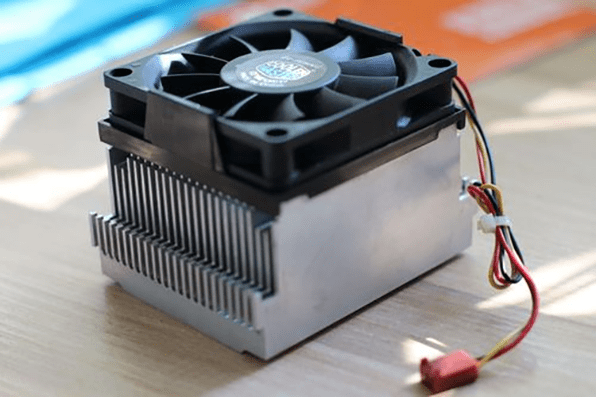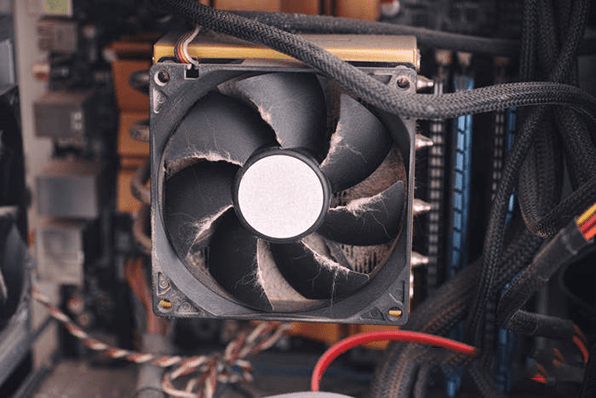
Figure 1: CPU fan.
Any electrical equipment will have a heat source during use, ranging from new energy equipment, charging piles,
energy storage equipment, wind energy equipment, cabinets and other equipment that have developed rapidly in recent
years, to desktop computers, printers, robots, servers, security monitoring, etc.
Thus, the installation of cooling fans is necessary to dissipate
heat to ensure that the equipment can work normally. This article analyzes the common failures and reasons for
computer cooling fans, and proposes some simple solutions.
1. Cooling Fan Not Rotating: Causes and Troubleshooting Methods
The failure of the cooling fan not to rotate can be checked according to the following troubleshooting methods.
1. Check if the fan motor is locked-rotor: Rotate the fan blades by hand to see if the fan cannot turn due to the
increased resistance caused by the accumulation of dust.
2. Check the bearing: Shake the fan blade gently by hand to check whether there is any sign of looseness to
determine whether the fan bearing is damaged.
3. Check the circuit: Check whether the connection point or plug of the cooling fan circuit is loose or falling off.
4. Test the fan: If possible, use an external power supply (with the same voltage as the fan) to power the cooling
fan separately to see if the fan can rotate.
5. Check the power supply of the fan: Check whether the power supply of the fan is normal, whether the power supply
voltage is within the rated voltage range of the cooling fan, and judge whether the voltage is too low to rotate the
fan.
6. Check the fan circuit: For cooling fans with speed regulation function, you need to check the model of the speed
regulation cable and whether the transmission is normal.
7. Replace the cooling fan with a new one for testing, and observe whether the fan is operating normally.

Figure 2: PC fan with dust on it.
1.1 What Will Happen If the Cooling Fan Does Not Turn?
If the cooling fan does not turn, it means that the heat generated by the equipment cannot be discharged in time, which will affect the normal operation of the equipment. The temperature rise of the equipment will affect the working efficiency of the equipment, which may cause irreversible damage to the components. If there is no temperature alarm and speed feedback for ordinary equipment, there is a risk of burning the equipment at any time.
2. Cooling Fan Oil Leakage: Reasons and Solutions
When you use the cooling fan, you may encounter the phenomenon of fan oil leakage, which not only affects the normal
use of the cooling fan, but also affects the aesthetics of the fan. The oil leakage of the cooling fan may be caused
by the following reasons.
1. Bearing problem
The oil bearings used by some cooling fans are porous in nature. If the bearings are used for a long time, the
lubricating oil in the bearing sleeve is easy to leak out, the noise will also increase, and it will also pollute
other accessories.
2. Lubricating oil problem
The main reason is that too much lubricating oil is added, resulting in overflow. In addition, if the lubricating
oil used is of poor quality, and not high in viscosity, it is also easy to cause oil leakage when the fan is
running.
3. Sealing problem
The cooling fan cover is usually sealed with a label to prevent oil leakage. Therefore, after tearing off the label
and adding lubricating oil, if the label is not reattached, or the label is not sticky enough, it may cause oil
leakage in the cooling fan.
If you encounter the problem of too much lubricating oil or sealing problem, you can try to solve it. If it is a
bearing problem, try to replace the bearing.

Figure 3: Tear off the label on the fan.
2.1 How to Add Lubricating Oil to Computer Fan?
The first step is to tear off the label on the fan shaft core, be careful not to tear it all off, and just make the
bearing be exposed. Because if it is all uncovered, the label will lack stickiness and it will not be easy to stick
it back.
After tearing off the label, you can use a small screwdriver or tweezers to pry off the oil seal cover in the middle
(some fans do not have it). Take one or two drops of lubricating oil, carefully drop it on the fan bearing, and turn
the fan blade once for each drop added to make the bearing can be adequately lubricated. Generally do not add too
much lubricating oil, and two drops are enough. If you add too much lubricating oil, it may overflow, causing dust
building up and affecting the normal operation of the fan.
After adding lubricating oil, remember to install the oil seal and stick the label back to its original place. Try
flipping the fan blades to see if it turns easily. If it doesn't turn smoothly, it's a sign that a little more oil
needs to be added until the fan spins completely freely.

Figure 4: Adding lubricating oil to a fan.
3. Loud Cooling Fan: Reasons and Solutions
The cooling fan may be accompanied by increasing noise after being used for a period of time. On the one hand, this
reflects the poor quality of the cooling fan. On the other hand, it may be caused by a poor environment or incorrect
installation angle. The reason why the cooling fan noise becomes louder is nothing more than dust (environmental
problems), bearing problems, installation problems, equipment problems, etc.
1. Environmental problems: This is relatively common. The fan works for a long time, and the fan blades and frame
are covered with dust. You can use a small brush or cotton swab to clean the dust. Pay attention to the strength and
touch the fan blades by using your fingers as little as possible to avoid dynamic balance imbalance.
2. Bearing problems: Generally, for fans with oil bearings after working for a long time, the lubricating oil will
gradually evaporate and reduce, which may cause bearing wear or imbalance, and increasing noise. At this time, the
fan needs to be maintained and some lubricating oil needs adding to the bearings.
3. Installation problems: Generally, cooling fans are installed with four corners fixed. If the four corners of the
fan are not installed on the same plane, the fan frame will be deformed. In addition, if the fan is installed, but
the noises other than the sound of the air channel will be generated when the fan works, consider adding
shock-absorbing rubber to the fan to reduce the resonance of the fixing bracket and reduce the noise.

Figure 5: Computer cooling fan.
4. Equipment problem: This is related to the entire equipment, especially if the design of the airflow channel of
the case is unreasonable, resulting in too high wind pressure in the air channel. Not only the heat dissipation and
exhaust are not smooth, but the fan bearing is easily damaged in the long run, so consider optimizing the airflow
channel.
5. Excessive load: When the computer performs a large number of tasks, components such as the CPU and graphics card
have a high workload, which requires more heat dissipation, and the fan speed will increase, resulting in more
noise.
6. Improper placement: If the computer is placed on an unstable surface, it may cause the fan to vibrate and make
noise.
7. Hardware problems: Some faulty or damaged hardware components may also cause abnormal operation of the fan and
cause noise.
3.1 Solution to Loud Fan Noise
According to the above possible reasons for the loud noise of the computer fan, the editor summarizes some tips to
reduce the noise of the fan. You can refer to the following methods.
1. Clean the fan and radiator. Open the computer case periodically to remove dust and grime from the fans and
heatsink. Using a can of compressed air can effectively blow dust away, ensuring that the fan can run smoothly and
reduce noise.

Figure 6: Use a brush to clean the cooling fan.
2. Replace the fan. If the fan is aging or damaged, consider replacing the fan. Choose a brand with reliable quality
and low noise to ensure compatibility with your computer.
3. Reduce the load. Computer fans will speed up under high load. Optimize task management, and close unnecessary
background applications to reduce load, which will help reduce fan noise.
4. Check for hardware problems. If having used the above troubleshooting methods, there is no obvious effect, it may
be a hardware failure that causes the abnormality of the fan. At this time, it is recommended to seek professional
technical support to check and repair possible hardware problems.
4. Conclusion
The computer fan is an important component to keep the internal temperature of the computer stable, and its normal operation is conducive to ensuring the normal heat dissipation and use of your computer. In daily life, you can regularly do maintenance checks for cooling fans, so once problems occur, they can be dealt with in time, which can effectively prolong the service life of fans.


